As a parent or caregiver, keeping your child’s toys clean and free of harmful germs and bacteria is essential for their health and well-being. However, with so many different types of toys and materials, it can be challenging to know the best way to clean and disinfect them. In this article, I will provide you with practical tips and techniques for cleaning and disinfecting toys to keep your child safe and healthy.
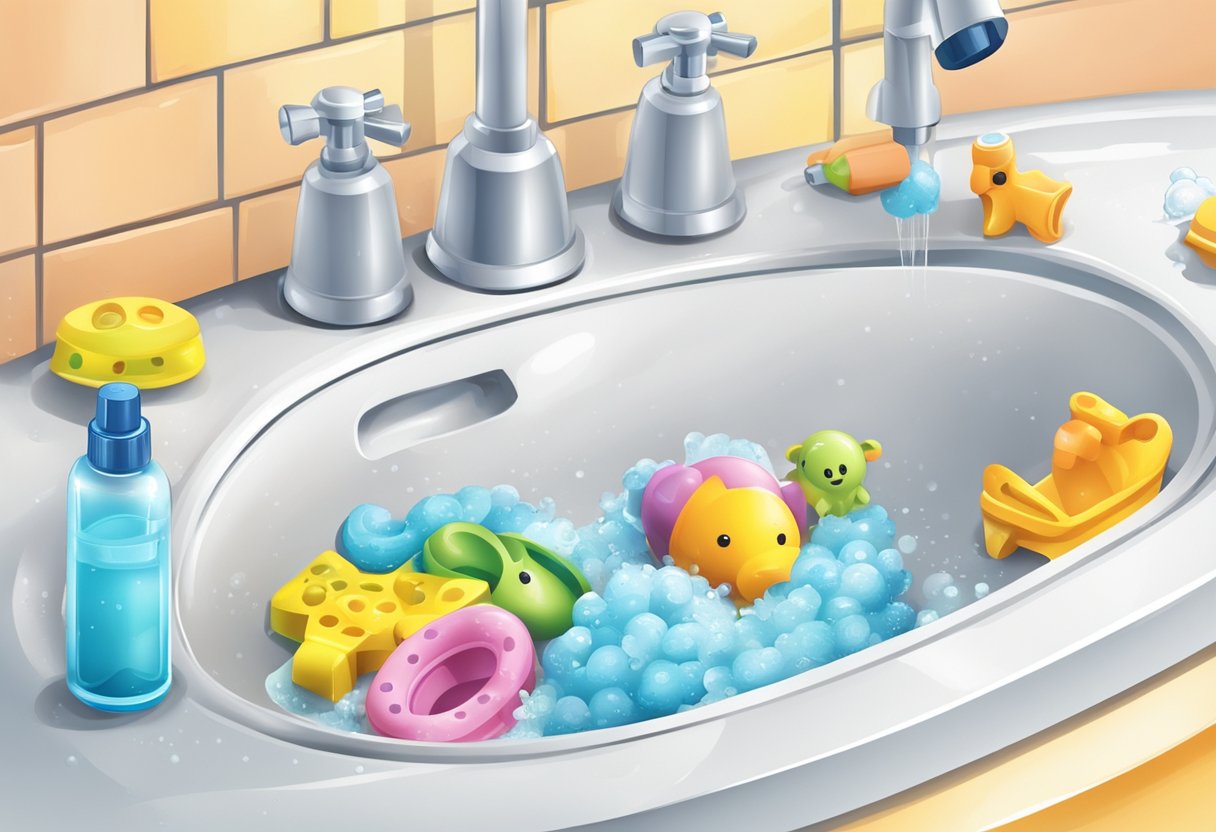
Understanding the importance of clean toys is crucial for parents and caregivers. Children often put toys in their mouths, which can lead to the spread of harmful germs and bacteria. Additionally, toys can collect dirt, dust, and other debris over time, making them a breeding ground for bacteria and viruses. By regularly cleaning and disinfecting toys, you can help prevent the spread of illness and keep your child healthy.
When it comes to cleaning toys, different types of toys require different cleaning methods. Plush toys, for example, may require different cleaning techniques than plastic toys. In the following sections, I will provide you with tips and techniques for cleaning and disinfecting various types of toys, as well as additional cleaning tips and frequently asked questions.
Key Takeaways
- Regularly cleaning and disinfecting toys is essential for preventing the spread of harmful germs and bacteria.
- Different types of toys require different cleaning methods, so it’s essential to understand your toy’s cleaning needs.
- By following the tips and techniques outlined in this article, you can keep your child’s toys clean and safe.
Understanding the Importance of Clean Toys
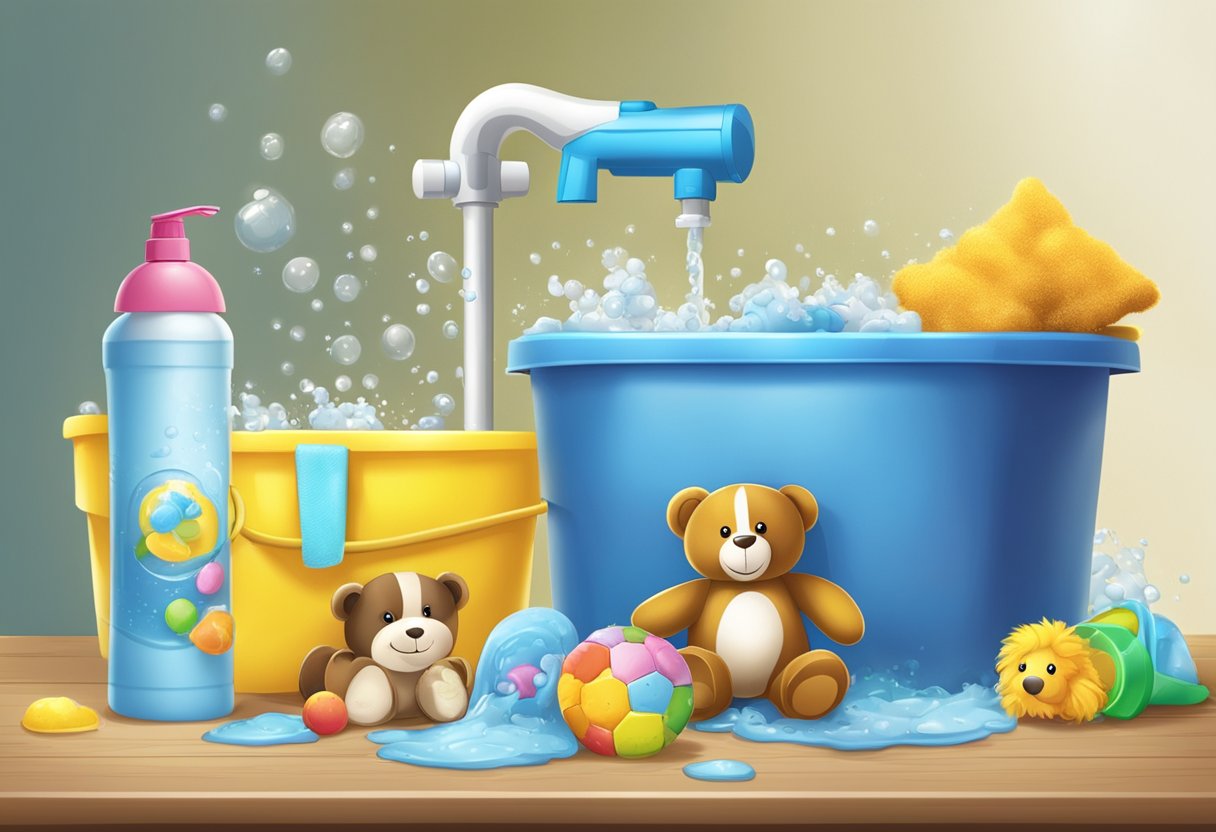
As a parent, I know how important it is to keep my child’s toys clean. Not only does it keep them looking nice, but it also helps to keep my child healthy by preventing the spread of germs and bacteria.
Did you know that toys can harbor a lot of germs? According to Good Housekeeping, toys can contain everything from fecal matter to mites. This is especially concerning for infants and young children who are more susceptible to illness.
Cleaning toys regularly can help prevent the spread of germs and bacteria. It’s important to use the right cleaning methods to ensure that toys are germ-free. For example, plastic toys can be cleaned with warm water and detergent, while stuffed animals can be placed in a plastic bag with baking soda to deodorize them.
It’s also important to disinfect toys regularly. According to Reviewed, you can make a disinfecting solution by combining white distilled vinegar and water in a spray bottle. Be sure to wipe the toy thoroughly with a microfiber cloth and get into any cracks or crevices with a Q-tip.
Overall, keeping toys clean and germ-free is an important part of keeping your child healthy. By cleaning and disinfecting toys regularly, you can help prevent the spread of germs and bacteria and keep your child safe and healthy.
Types of Toys and Their Cleaning Needs
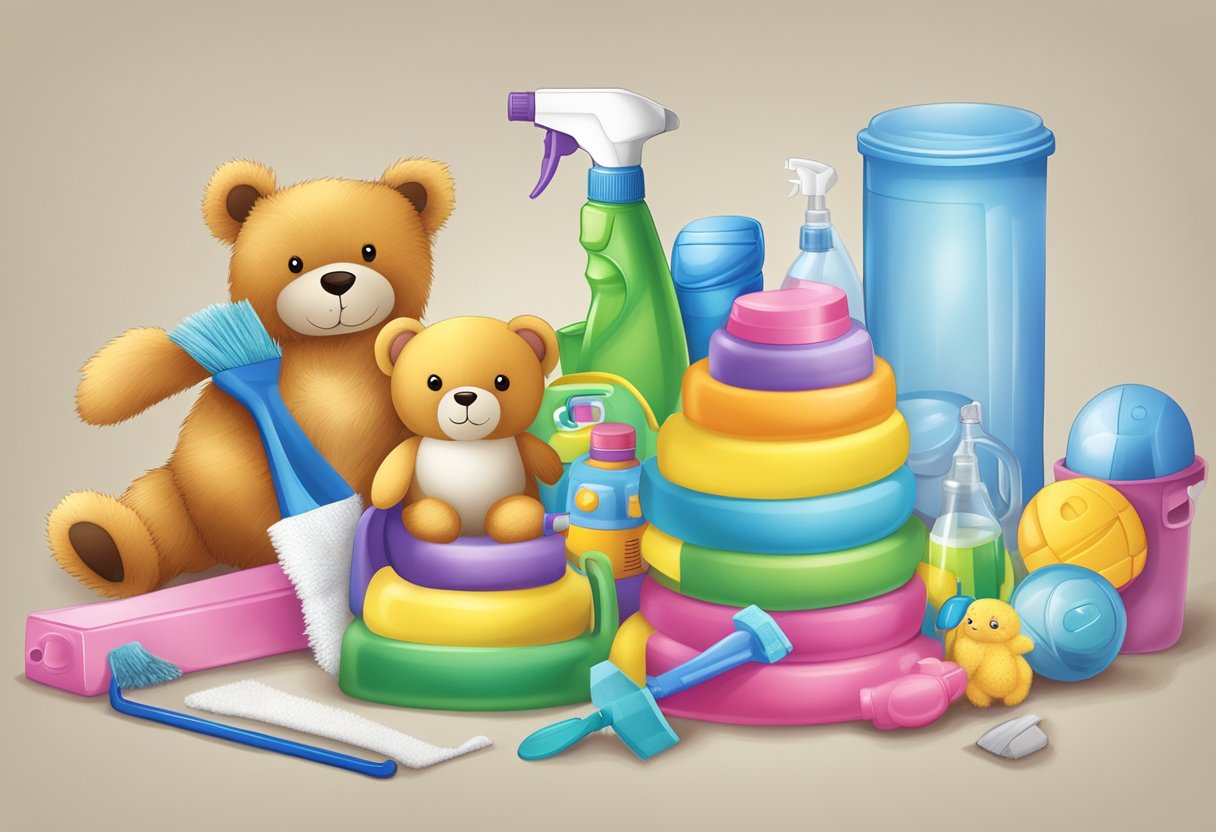
As a parent, I know that keeping toys clean and sanitized is important for the health and safety of our children. However, different types of toys require different cleaning methods. Here are some tips for cleaning and disinfecting various types of toys.
Hard Plastic Toys
Hard plastic toys, such as building blocks and action figures, can be easily cleaned with soap and water. For a more thorough cleaning, you can use a solution of 1/4 cup of bleach per gallon of water. Be sure to rinse the toys thoroughly and let them air dry.
Plush Toys
Plush toys, such as stuffed animals, can be a bit trickier to clean. First, remove any loose dirt or debris. Then, check the care label to see if the toy is machine washable. If it is, place it in a pillowcase or laundry bag to protect it and wash on a gentle cycle with mild detergent. If the toy is not machine washable, you can spot clean it with a mixture of water and mild detergent. Be sure to rinse thoroughly and let it air dry.
Wooden Toys
Wooden toys, such as blocks and puzzles, can be cleaned with a damp cloth and mild soap. Avoid using harsh chemicals or soaking the toys in water, as this can damage the wood. After cleaning, be sure to let the toys air dry completely.
Electronic Toys
Electronic toys, such as tablets and gaming devices, should be cleaned with a soft, dry cloth. Avoid using water or cleaning solutions, as these can damage the electronic components. If the device has a protective case, be sure to remove it and clean it separately.
Bath Toys
Bath toys, such as rubber ducks, can become breeding grounds for mold and mildew if not properly cleaned. After each use, squeeze out any excess water and let the toy air dry. Once a week, soak the toys in a solution of 1/4 cup of bleach per gallon of water for 5 minutes, then rinse thoroughly and let them air dry.
Outdoor Toys
Outdoor toys, such as bikes and scooters, can be cleaned with soap and water. Be sure to rinse them thoroughly and let them air dry. For a more thorough cleaning, you can use a pressure washer or hose with a high-pressure nozzle. Be sure to check the manufacturer’s instructions before using any cleaning method.
Remember, keeping toys clean and sanitized is an important part of keeping our children healthy. By following these tips, you can help ensure that your child’s toys are safe and germ-free.
The Cleaning Process
https://www.youtube.com/watch?v=dldWxSHSJJA&embed=true
Cleaning and disinfecting toys is important to keep children healthy and safe. Here are some ways to clean and disinfect toys, depending on the type of toy and its material.
Hand Washing
Hand washing is a simple and effective way to clean toys. Fill a basin or sink with warm water and add a small amount of mild soap. Immerse the toys in the soapy water and use a soft-bristled brush or cloth to scrub the surfaces. Rinse the toys thoroughly with clean water and let them air dry.
Machine Washing
Some toys can be washed in a washing machine. Check the care label on the toy to see if it is machine washable. Place the toys in a mesh laundry bag to protect them during the wash cycle. Use a gentle detergent and select a delicate cycle with cold or warm water. Once the cycle is complete, remove the toys from the bag and let them air dry.
Spot Cleaning
For toys that cannot be fully immersed in water, spot cleaning is a good option. Mix a small amount of mild soap with warm water and use a soft cloth or sponge to clean the surfaces of the toy. Rinse the toy with clean water and let it air dry.
Steam Cleaning
Steam cleaning is an effective way to disinfect toys without using chemicals. Use a handheld steam cleaner with a nozzle attachment to steam the surfaces of the toys. Be sure to follow the manufacturer’s instructions for the steam cleaner and use caution when handling hot steam.
Remember to always surface clean toys after each use to prevent the spread of germs. Regular cleaning and disinfecting of toys can help keep children healthy and safe.
Disinfecting Toys
https://www.youtube.com/watch?v=aqPP-LmUwZA&embed=true
As a parent, I understand the importance of keeping my child’s toys clean and germ-free. Disinfecting toys is an essential part of ensuring that your child stays healthy and safe. In this section, I will discuss the three most effective ways to disinfect toys: using bleach, vinegar, and hydrogen peroxide.
Using Bleach
Bleach is a powerful disinfectant that can kill germs and bacteria on toys. To use bleach to disinfect toys, you will need to mix 1/2 cup of bleach with one gallon of water. Be sure to keep the toy’s surface wet for at least 10 seconds to sanitize with a wipe or for the time recommended on the product’s label. After that, rinse the toy thoroughly with water and allow it to air dry.
It is essential to note that bleach can be harsh on some toys, especially those made of fabric or with paint. Before using bleach, check the toy’s label to ensure that it is safe to use.
Using Vinegar
Vinegar is a natural sanitizer that can kill germs and bacteria on toys. To use vinegar to disinfect toys, you will need to mix 1/3 cup of white distilled vinegar with 2/3 cup of water in a clean spray bottle. Spray the toy with the solution and wipe it thoroughly but firmly with a microfiber cloth. Use a Q-tip to get in any cracks, crannies, buttons, or knobs. Wipe the toy dry with a clean towel before returning it to your child.
Vinegar is safe to use on most surfaces but can damage some toys, especially those made of marble or stone. Before using vinegar, check the toy’s label to ensure that it is safe to use.
Using Hydrogen Peroxide
Hydrogen peroxide is a powerful disinfectant that can kill germs and bacteria on toys. To use hydrogen peroxide to disinfect toys, you will need to mix equal parts of hydrogen peroxide and water in a clean spray bottle. Spray the toy with the solution and let it sit for at least five minutes before wiping it down with a clean cloth. Rinse the toy with water and allow it to air dry.
Hydrogen peroxide is safe to use on most surfaces but can bleach some toys, especially those made of fabric or with paint. Before using hydrogen peroxide, check the toy’s label to ensure that it is safe to use.
In conclusion, disinfecting toys is an essential part of keeping your child healthy and safe. By using bleach, vinegar, or hydrogen peroxide, you can effectively kill germs and bacteria on your child’s toys. Remember to always check the toy’s label before using any disinfectant to ensure that it is safe to use.
Drying and Storing Toys
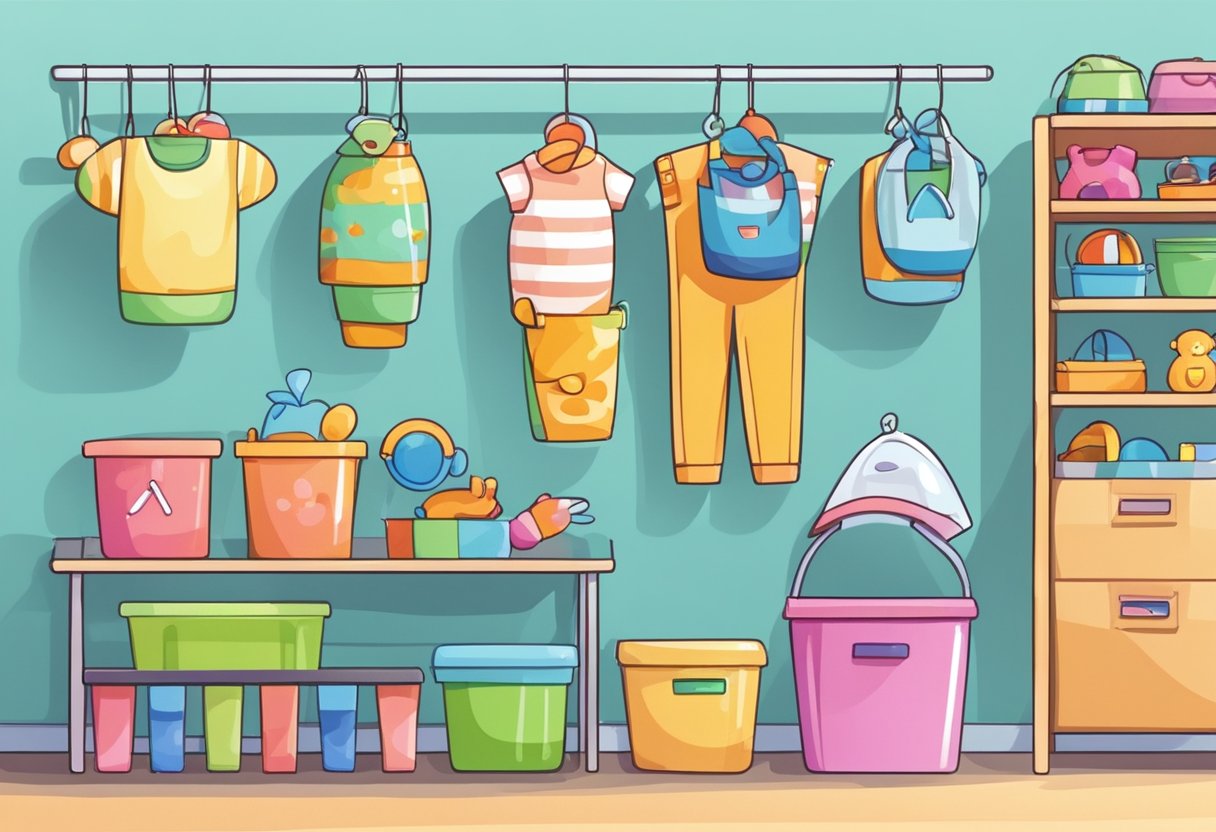
Once you’ve cleaned and disinfected your child’s toys, it’s important to dry them thoroughly before storing them away. Here are some tips for drying and storing toys:
- Air dry: The easiest way to dry toys is to simply let them air dry. Place them on a clean towel or rack and let them dry naturally. Make sure they are completely dry before storing them away.
- Hair dryer: If you need to dry toys quickly, you can use a hair dryer on the cool setting. Hold the hair dryer several inches away from the toy and move it around to dry all sides. Be careful not to overheat the toy or damage any delicate parts.
- Mesh bag: If you’re washing small toys like Legos or action figures, you can put them in a mesh bag before washing them. This will help keep them from getting lost in the washing machine and make them easier to dry.
- Pillowcase: Another option for small toys is to put them in a pillowcase before washing them. Tie the pillowcase closed and wash it on a gentle cycle. This will help protect the toys from getting scratched or damaged during the wash cycle.
- Spray bottle: To help toys dry faster, you can use a spray bottle to mist them with rubbing alcohol or hydrogen peroxide. This will help speed up the drying process and kill any remaining germs.
Remember to store clean toys in a dry and cool place, away from direct sunlight. Avoid storing them in damp or humid areas, as this can encourage the growth of mold and bacteria. By following these simple tips, you can keep your child’s toys clean and safe for playtime.
Preventing Germs and Bacteria
https://www.youtube.com/watch?v=BOM4w9pbGcE&embed=true
As a parent, keeping your child’s toys clean and germ-free is essential to their health and well-being. Germs and bacteria can easily accumulate on toys and can cause illnesses such as colds, flu, and other infections. Here are some tips on how to prevent germs and bacteria from spreading on your child’s toys:
Regular Cleaning
Regular cleaning is the first step in preventing the spread of germs and bacteria on toys. Depending on the type of toy, you can use soap and water, a disinfectant spray, or wipe to clean it. For plastic toys, use a mild detergent and warm water to clean the surface. For stuffed animals and fabric toys, use a washing machine with warm water and a gentle detergent. It is recommended to clean toys at least once a week, or more frequently if your child is sick.
Disinfecting
Disinfecting toys is essential to kill germs and bacteria that may be present on the surface. A solution of 1/2 cup of chlorine bleach and one gallon of water can be used to disinfect toys. Be sure to keep the toy’s surface wet for at least 10 seconds to sanitize with a wipe (or for the time recommended on the product’s label) and for 5 minutes if you are using a spray. Always remember to rinse the toy thoroughly with water after disinfecting it.
Storing Toys
Storing toys properly is also important to prevent the spread of germs and bacteria. Keep toys in a clean and dry place, away from areas where they can easily get dirty. Avoid storing toys in damp areas, such as basements or garages, as this can promote the growth of mold and bacteria. Additionally, it is recommended to store toys in a toy box or bin with a lid to keep them clean and dust-free.
Other Tips
Here are some other tips to prevent the spread of germs and bacteria on toys:
- Encourage your child to wash their hands frequently, especially after playing with toys.
- Avoid sharing toys with other children, especially if they are sick.
- Replace old or damaged toys, as they can harbor germs and bacteria.
- Vacuum carpets and rugs regularly to remove dust and dust mites that can accumulate on toys.
- Wash bedding and stuffed animals in hot water to kill dust mites and other allergens.
By following these simple tips, you can ensure that your child’s toys are clean and germ-free, promoting a healthy and happy environment for them to play and grow in.
Additional Cleaning Tips
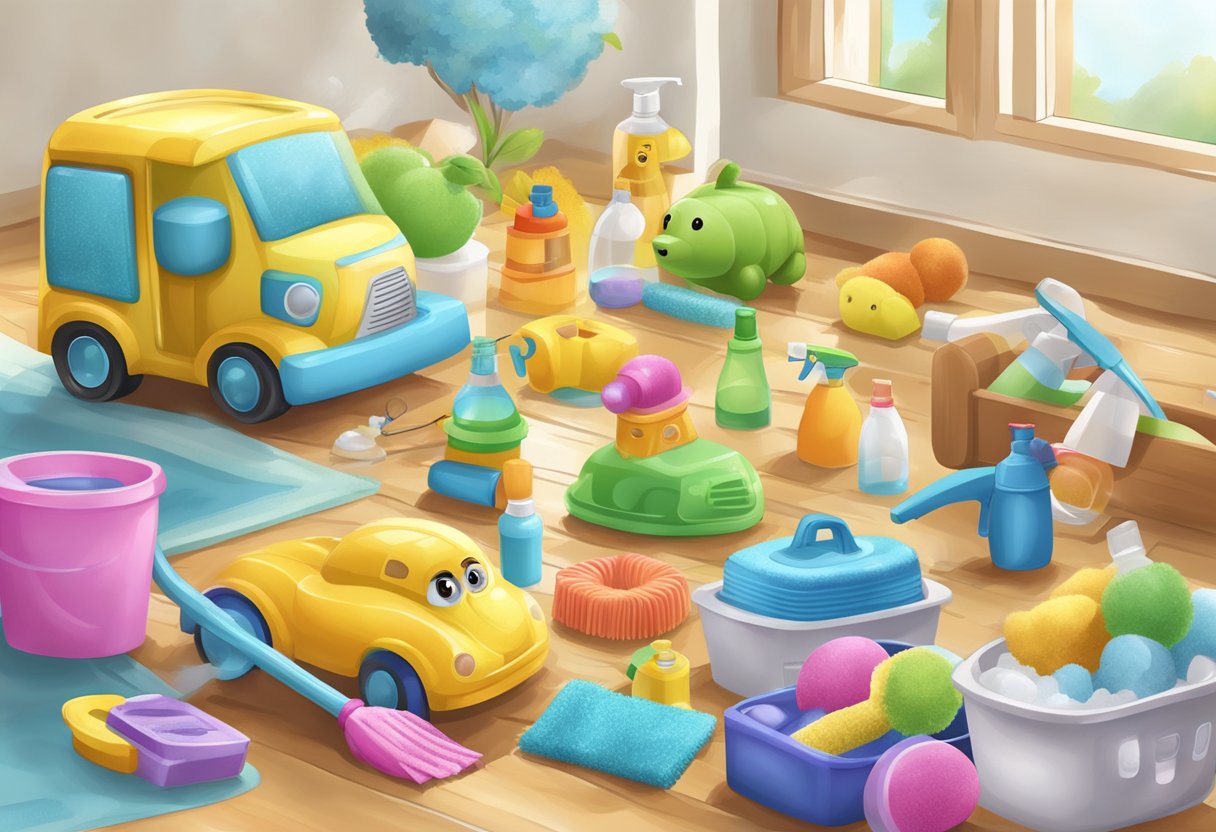
When it comes to cleaning and disinfecting toys, there are a few additional tips that can help ensure they are thoroughly sanitized and safe for children to play with.
One thing to keep in mind is that some toys may be too delicate to withstand a full wash cycle in the washing machine or dishwasher. In these cases, it may be best to use a gentle cycle or hand wash the toys using a soft brush and mild detergent.
For larger toys, such as ride-on cars or play kitchens, it may be necessary to soak them in a gallon of water with hot water and dishwasher detergent to ensure they are properly disinfected. Be sure to rinse them thoroughly and allow them to dry completely before allowing children to play with them again.
Another effective cleaning solution is white vinegar, which can be used to sanitize most surfaces and kill various food-borne pathogens such as E. coli. To use white vinegar, simply mix equal parts water and vinegar in a spray bottle and apply to toys, wiping them down with a microfiber cloth.
It’s important to note that the water temperature used for cleaning and disinfecting toys can also play a role in their effectiveness. Hot water is generally recommended for killing germs, but be sure to check the manufacturer’s instructions to ensure you are not using water that is too hot and could damage the toys.
Overall, by following these additional cleaning tips and utilizing a combination of cleaning methods, you can help ensure that your child’s toys are thoroughly disinfected and safe for them to play with.
Frequently Asked Questions
How can I effectively disinfect my child’s toys?
To effectively disinfect your child’s toys, you can use a solution of one part white vinegar and one part water. Simply spray the solution onto the toys and let it sit for a few minutes before wiping it off with a clean cloth. Another effective disinfectant is a solution of one tablespoon of bleach mixed with one gallon of water. Be sure to keep the toy’s surface wet for at least 10 seconds to sanitize with a wipe, or for the time recommended on the product’s label.
What household items can I use to clean my child’s toys?
There are several household items that you can use to clean your child’s toys. Mild soap and water is a great option for most toys, especially those made of plastic. You can also use a solution of one part white vinegar and one part water to clean and disinfect toys. Baking soda is another great option for cleaning stuffed toys. Simply pour a half-cup baking soda into a plastic garbage bag, add several stuffed toys to the bag, seal the bag, and shake the toys vigorously for a minute or two. Leave the toys in the bag for 15 minutes to allow the baking soda to deodorize the toys.
Can I use bleach to disinfect my child’s toys?
Yes, you can use bleach to disinfect your child’s toys. However, it’s important to dilute the bleach properly before using it. Mix one tablespoon of bleach with one gallon of water to create a solution that is safe for disinfecting toys. Be sure to keep the toy’s surface wet for at least 10 seconds to sanitize with a wipe, or for the time recommended on the product’s label.
Is vinegar a safe and effective way to clean toys?
Yes, vinegar is a safe and effective way to clean toys. Vinegar is a natural disinfectant that can kill germs and bacteria on toys. Simply mix one part white vinegar and one part water in a spray bottle and spray the solution onto the toys. Let the solution sit for a few minutes before wiping it off with a clean cloth.
Can I wash plastic toys in the washing machine?
No, you should not wash plastic toys in the washing machine. The high heat and agitation of the washing machine can damage the toys and cause them to break or warp. Instead, wash plastic toys by hand using mild soap and water.
What is the best way to kill germs on toys?
The best way to kill germs on toys is to use a disinfectant solution of one part white vinegar and one part water. You can also use a solution of one tablespoon of bleach mixed with one gallon of water. Be sure to keep the toy’s surface wet for at least 10 seconds to sanitize with a wipe, or for the time recommended on the product’s label.
